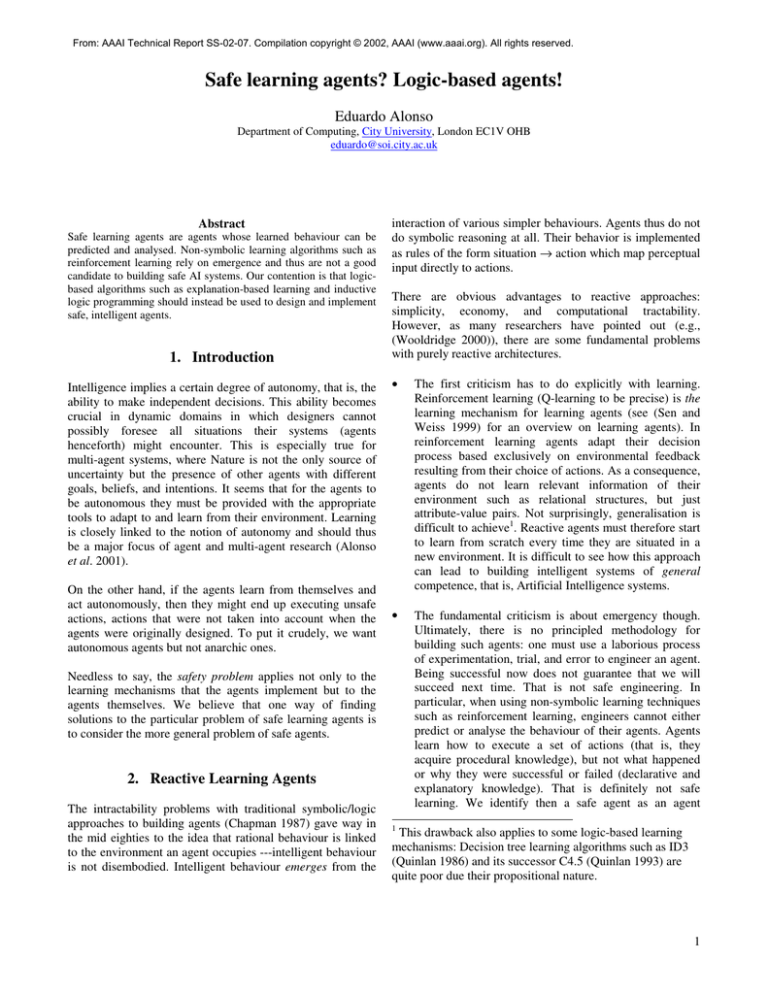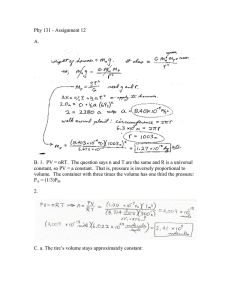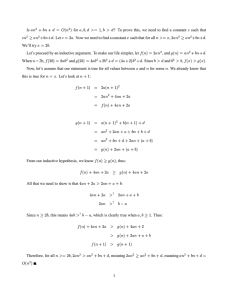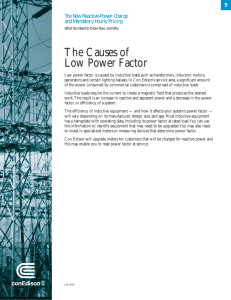
From: AAAI Technical Report SS-02-07. Compilation copyright © 2002, AAAI (www.aaai.org). All rights reserved.
Safe learning agents? Logic-based agents!
Eduardo Alonso
Department of Computing, City University, London EC1V OHB
eduardo@soi.city.ac.uk
Abstract
Safe learning agents are agents whose learned behaviour can be
predicted and analysed. Non-symbolic learning algorithms such as
reinforcement learning rely on emergence and thus are not a good
candidate to building safe AI systems. Our contention is that logicbased algorithms such as explanation-based learning and inductive
logic programming should instead be used to design and implement
safe, intelligent agents.
1. Introduction
Intelligence implies a certain degree of autonomy, that is, the
ability to make independent decisions. This ability becomes
crucial in dynamic domains in which designers cannot
possibly foresee all situations their systems (agents
henceforth) might encounter. This is especially true for
multi-agent systems, where Nature is not the only source of
uncertainty but the presence of other agents with different
goals, beliefs, and intentions. It seems that for the agents to
be autonomous they must be provided with the appropriate
tools to adapt to and learn from their environment. Learning
is closely linked to the notion of autonomy and should thus
be a major focus of agent and multi-agent research (Alonso
et al. 2001).
On the other hand, if the agents learn from themselves and
act autonomously, then they might end up executing unsafe
actions, actions that were not taken into account when the
agents were originally designed. To put it crudely, we want
autonomous agents but not anarchic ones.
interaction of various simpler behaviours. Agents thus do not
do symbolic reasoning at all. Their behavior is implemented
as rules of the form situation → action which map perceptual
input directly to actions.
There are obvious advantages to reactive approaches:
simplicity, economy, and computational tractability.
However, as many researchers have pointed out (e.g.,
(Wooldridge 2000)), there are some fundamental problems
with purely reactive architectures.
•
The first criticism has to do explicitly with learning.
Reinforcement learning (Q-learning to be precise) is the
learning mechanism for learning agents (see (Sen and
Weiss 1999) for an overview on learning agents). In
reinforcement learning agents adapt their decision
process based exclusively on environmental feedback
resulting from their choice of actions. As a consequence,
agents do not learn relevant information of their
environment such as relational structures, but just
attribute-value pairs. Not surprisingly, generalisation is
difficult to achieve1. Reactive agents must therefore start
to learn from scratch every time they are situated in a
new environment. It is difficult to see how this approach
can lead to building intelligent systems of general
competence, that is, Artificial Intelligence systems.
•
The fundamental criticism is about emergency though.
Ultimately, there is no principled methodology for
building such agents: one must use a laborious process
of experimentation, trial, and error to engineer an agent.
Being successful now does not guarantee that we will
succeed next time. That is not safe engineering. In
particular, when using non-symbolic learning techniques
such as reinforcement learning, engineers cannot either
predict or analyse the behaviour of their agents. Agents
learn how to execute a set of actions (that is, they
acquire procedural knowledge), but not what happened
or why they were successful or failed (declarative and
explanatory knowledge). That is definitely not safe
learning. We identify then a safe agent as an agent
Needless to say, the safety problem applies not only to the
learning mechanisms that the agents implement but to the
agents themselves. We believe that one way of finding
solutions to the particular problem of safe learning agents is
to consider the more general problem of safe agents.
2. Reactive Learning Agents
The intractability problems with traditional symbolic/logic
approaches to building agents (Chapman 1987) gave way in
the mid eighties to the idea that rational behaviour is linked
to the environment an agent occupies ---intelligent behaviour
is not disembodied. Intelligent behaviour emerges from the
1
This drawback also applies to some logic-based learning
mechanisms: Decision tree learning algorithms such as ID3
(Quinlan 1986) and its successor C4.5 (Quinlan 1993) are
quite poor due their propositional nature.
1
whose behavior is liable to be predicted and analysed.
The same applies to safe learning agents. Safe learning
agents are agents whose learning is predictable and
analysable.
Of course, most agent architectures are not purely reactive.
Since Georgeff and Lansky’s developed their Procedural
Reasoning System (PRS (Georgeff and Lansky, 1986)) based
on a BDI architecture, reaction and deliberation come hand
in hand. Our contention is that a logic-based approach is
needed to designing, implementing, and evaluating
intelligent safe agents, not that reaction is intrinsically
unsafe. Serious attempts have been made to combine
reinforcement learning with logical/relational learning (e.g.,
Relational Reinforcement Learning, (Dzeroski et al. 2001)).
hypothesis based on its own local data (Domingos
1996).
Regardless of the learning technique used, the safety of these
approaches is still under investigation,. However, we think
that symbolic approaches are better suited than non-symbolic
approaches in terms of safety. Symbolic/logic approaches
provide a clear, well-defined, and natural representational
language in terms of both syntax and semantics. Moreover,
theorem proving as a metaphor for reasoning is subject to
analysis. Coherence and completeness will determine how
safe a system is.
What about learning? Again, we believe that knowledge
(logic)-based learning mechanisms would give us the
appropriate tools to building safe agents. We will focus on
two logic-based learning mechanisms, namely, explanationbased learning and inductive logic programming.
3. Logic-Based Learning Agents
3.1. Explanation-Based Learning
Like some AI pioneers (e.g. (Nilsson 1995)), we believe that
it is time to come back to Good-Old Fashioned Artificial
Intelligence (GOFAI). From an operational point of view,
distributed AI (aka Multi-Agent Systems) has proven to
solve some of the tractability problems which traditional
symbolic approaches suffered from2. By distributing the
computational load among different specialised agents, we
gain both in speed (parallelism) and quality of the solutions.
Admittedly, distributed learning makes things a little more
complicated. If the rules are learned from different sources,
the system should guarantee that the rules are no in conflict
with each other. Current distributed learning methods
employ one of two general approaches:
•
Hypothesis combination: Each agent individually
computes a local hypothesis based on the local training
data which are then combined into a global hypothesis,
either by a separate agent (e.g., Fayyad et al. 1993), or
collaboratively by the local agents (e.g., Provost and
Hennessy, 1996).
•
Hypothesis update: One agent starts by learning a local
hypothesis from the local training data, and then
communicating it to another agent which updates its
Explanation-based learning (EBL) (Mitchell et al. 1986) has
been widely used in Artificial Intelligence to speed-up the
performance of planners (e.g, in Prodigy (Carbonell et al.
1990)). Generally speaking, the agents are concerned in
improving the efficiency of the problem solver rather than
acquiring new knowledge. Obviously, problem solvers, when
presented with the same problem repeatedly, should not
solve it the same way and in the same amount of time. On
the contrary, it seems sensible to use general knowledge to
analyze, or explain, each problem solving instance in order
to optimize future performance. This learning is not merely a
way of making a program run faster, but a way of producing
qualitative changes in the performance of a problem-solving
system.
In short, EBL extracts general rules from single examples by
generating an explanation why the system succeeded or
failed, and generalizing it. This provides a deductive (rather
than statistical) method to turn first-principles knowledge
into useful, efficient, special-purpose expertise. The learned
rules enable the planner to make the right choice if a similar
situation arises during subsequent problem solving. As a
deductive (learning) mechanism, EBL is open to analysis and
is thus safe. If the domain theory is correct and complete,
certain algorithms such as PROLOG-EBG (Kedar-Cabelli
and McCarty 1987) produce justified general hypothesis.
2
It has been shown that distributing problem solving over
several levels of abstraction reduces the time complexity of
the planning process (Korf 1987; Montgomery and Durfee
1993). In the same way, in a hierarchical MAS, the learning
module can be applied within each abstract problem space.
Since the abstract problem spaces define more general and
thus simpler problems and theories, agents learn more
efficient and appropriate rules (Knoblock et al. 1991).
3.2. Inductive Logic Programming
It is one thing to deduce from general rules more rules that
should, in theory, lead to a successful plan; it is another to
learn from examples (and some prior knowledge) whether
the conditions for such plan to be executed successfully do
2
actually hold. In contrast to EBL methods, inductive logic
programming (ILP (Muggleton and de Raedt 1994))
computes a hypothesis not just based on general rules known
beforehand but also on external and initially unknown
circumstances. Generally, relying exclusively on EBLgenerated rules can turn out to be impractical in real-world
domains in which agents work with incomplete knowledge,
and thus ILP is an important addition to the system’s
effectiveness.
ILP methods compute an inductive hypothesis with the help
of training data (positive and negative examples) and
background knowledge. As depicted in Figure 1, agents
collect training examples based on executed actions and
plans and their outcome. This, together with the domain
knowledge base and a target predicate (e.g., success or
failure) forms the basis of the inductive learning process
which computes a hypothesis (i.e., a definition of the target
predicate) that can be used in subsequent planning.
our contention that logic-based agents are the sort of agents
that are liable to be analyzed in such way. Therefore, logicbased agents are safer than non-symbolic, reactive agents.
Following this line of argumentation, we believe that logicbased learning mechanisms are safer than non-symbolic
learning techniques such as reinforcement learning or neural
networks.
We are developing a conflict simulator to prove this
hypothesis (Alonso and Kudenko, 1999; Kudenko and
Alonso 2001). The idea is to show that EBL and ILP are safe
learning mechanisms in highly risky domains, such as a
simulated battlefield. Tara A. Estlin has also studied how to
apply multi-strategy learning (EBL plus ILP) to improve
planning efficiency and quality.
References
Alonso, E. and Kudenko, D. 1999. Machine learning
techniques for adaptive logic-based multi-agent systems. In
Proc. UKMAS-99.
Alonso, E., d’Inverno, M., Luck, M., Kudenko, D. and
Noble, J. 2001. Learning in Agents and Multi-Agent
Systems, Knowledge Engineering Review. Forthcoming.
Figure 1. Inductive Logic Programming
Whereas traditional computational logic theory describes
deductive inference from logic formulae provided by the
user, ILP theory describes the inductive inference of logic
programs from instances and background knowledge. In this
manner, ILP may contribute to the practice of logic
programming, by providing tools that assist to develop and
verify programs (agents). ILP is based upon inductive
inference rules that yield to a ‘’proof theory’’, namely,
inverse resolution (Muggleton 1995). As long as ILP is
based on a strong theoretical background that allows
analysis, we can conclude that it might lead to safe learning.
4. Conclusions and Further Work
In this paper, we have argued that safe agents are those
agents over which the designer might exercise some control.
Admittedly, in complex, dynamic domains, it is impossible
to have complete control over the domain. However,
designers should be able to analyze the behavior of their
agents and to predict it more accurately as time passes. It is
Carbonell, J., Knoblock, C. and Minton, S. 1990.
PRODIGY: An integrated architecture for planning and
learning. In van Lehn, K. (ed.) Architectures for Intelligence.
Hillsdale, NJ: Lawrence Erlbaum Associates.
Chapman, D. 1987. Planning for conjunctive goals. Artificial
Intelligence, 32(3):333-377.
Domingos, P. 1996. Efficient specific-to-general rule
induction. In Proc. Of the Second International Conference
on Knowledge Discovery and Data Mining.
Dzeroski, S., De Raedt, L. and Driessens, K. 2001.
Relational Reinforcement Learning. Machine Learning,
43(1/2): 7-52.
Estlin, T. 1995. Using Multi-Startegy Learning to Imporve
Planning Efficiency and Quality. PhD thesis, University of
Texas at Austin.
Fayyad, U., Weir, N. and Djorgovski, S. 1993. SKICAT: A
machine learning system for automated cataloging of large
scale sky surveys. In Proc. of the Tenth International
Conference on Machine Learning.
Georgeff, M.P. and Lansky, A.L. 1986. Procedural
Knowledge. In Proc. of the IEEE, 74: 1383-1398.
3
Kaelbling, L.P., Littman, M.L. & Moore, A.W. 1996.
Reinforcement learning: A survey. Journal of Artificial
Intelligence Research 4: 237-285.
Wooldridge, M. 2000. Computationally grounded theories of
agency. In E. Durfee, editor, Proceedings of the Fourth
International Conference on Multi-Agent Systems (ICMAS
2000). IEEE Press.
Kedar-Cabelli, S. and McCarty, T. 1987. Explanation-based
generalization as resolution theorem proving. In Proc. of the
Fourth International Workshop on Machine Learning, 383389. San Francisco, CA: Morgan Kaufmann.
Knoblock, C.A., Minton, S. and Etzioni, O. 1991. Integrating
Abstraction and Explanation-Based Learning in PRODIGY.
In Proceedings of The Ninth National Conference on
Artificial Intelligence AAAI-91, 93-102. Menlo Park, CA:
AAAI Press.
Korf, R.E. 1987. Planning as search: A qualitatuve approach.
Artificial Intelligence 33(1): 65-88.
Kudenko, D. and Alonso, E. 2001. Machine learning
techniques for logic-based multi-agent systems. Proceedings
of the First Goddard Workshop on Formal Approaches to
Agent-Based Systems, NASA Goddard Space Flight Center,
MD, USA. Springer-Verlag.
Montgomery, T. A. and Durfee, E. H. 1993. Search
reduction in hierarchical distributed problem solving. Group
Decision and Negotiation 2: 301-317.
Muggleton, S. and de Raedt, L. 1994. Inductive logic
programming: theory and methods. Journal of Logic
Programming 19: 629-679.
Muggleton, S. 1995. Inverse entailment and progol. New
Generation Computing Journal, 13: 245-286.
Mitchell, T.M., Keller, R. and Kedar-Cabelli, S. 1986.
Explanation-based generalisation: A unifying view. Machine
Learning 1: 4-80.
Nilsson, N. 1995. Eye on the prize. AI Magazine.
Provost, F. and Hennessy, D. 1996. Scaling up: distributed
machine learning with cooperation. In Proc. of the
Thirteenth National Conference on Artificial Intelligence,
AAAI-96.
Quinlan, J.R. 1986. Induction of decision trees. Machine
Learning 1(1): 81-106.
Quinlan, J.R. 1993. C4.5: Programs for Machine Learning.
San Mateo, CA: Morgan Kaufmann.
Sen, S. and Weiss, G. 1999. Learning in Multiagent systems.
In G. Weiss, editor, Multiagent systems: A modern approach
to distributed artificial intelligence. Mass: The MIT Press.
4









